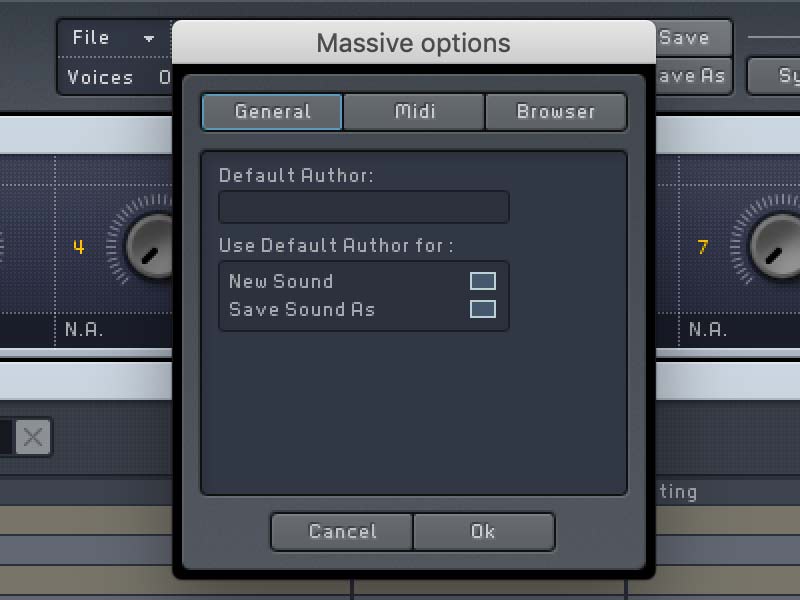More than only supersaws – discover unsuspected sound facettes of your JP6K. The Experience soundset is loaded with 64 high-end sounds, containing grinding basses, super-fat lead sounds, followed by delightful pads and plucks up to juicy synth sounds.
JP6K is a synth dedicated to emulating the famous Super Saw sound, first found in the Roland JP-8000 synthesizer in 1997. It aims to capture the essence of the sound and the behaviour of the original oscillator. Even after a decade, the Super Saw is still sought after by people all around the world, and is a crucial part of such music genres like Trance.
There are several factors that make the Super Saw in the JP6K different than other synths that provide a similar sound. The original Super Saw from Roland was aliasing, thus creating a bright and 'airy' sound. To prevent the sound from sounding harsh below the fundamental harmonic, a high pass filter was possibly used to remove the unwanted frequencies. The JP6K uses the same design to achieve that special oscillator waveform giving it a unique tone.
Another important aspect of the classic Super Saw, was its special detune curve. It was non-linear, which gave the user greater control over the detune amount. Even when the detune control was half way, the spread of the detune was small, which made it possible to make very smooth sounding pads. The curve then gradually increased, and at higher values, the detune rapidly spread out to maximum. This unique curve is accurately modelled in JP6K, making it nearly identical to the detune in the hardware.
The JP6K also emulates other features from the JP-8000 like the filters, key tracking and the EQ, to give it an even more authentic way to shape the Super Saw sound. The synth has been optimised to use minimal amount of CPU, so it is possible to use multiple instances.
Key features:
- 32 voice polyphony.
- Two Super Saw oscillators, an upper and lower.
- 1 noise oscillator.
- Three filter modes: low pass, band pass and high pass with -12 & -24 dB/Oct.
- Three independent LFOs controlling the filter, amp and pitch.
- Built in delay and EQ.
Buy ArchiAD 22 Online
infinite skills video and animation with adobe photoshop
GreatStoreSoftware.COM
Jp6k vst knobs and sliders can be controlled by clicking on them, and dragging up or down in a vertical direction. To reset the controls to their default value, hold down CTRL while clicking on the controls. The main detune knob also allows the user to jp6k vst change the detune and mix jp6k vst at the same time. To do this, click on the detune lines inside the detune knob marked red areaand move the mouse in a horizontal direction to control the detune, and move it in a vertical direction to control the mix.
The knobs and sliders can be controlled by clicking on them, and dragging up or down in a vertical direction. To reset the controls to their default value, hold down CTRL while clicking on the controls. The main detune knob also allows the user to simultaneously change the detune and mix controls at the same time. To do this, click on the detune lines inside the detune knob marked red area , and move the mouse in a horizontal direction to control the detune, and move it in a vertical direction to control the mix.
Holding down CTRL while clicking on the detune lines, resets both the detune and mix controls to their default value. When clicking on the selector buttons several times, it scrolls through the different selection options.
It is also possible to click directly on the desired selection to mark it. Page 1 The display is an important area of the synth. It shows the current preset name, and displays the value and name of a control, when the mouse pointer is hovering over it. By left clicking on the display, the presetlist comes up, and it is possible to select a preset directly from this list. One can also use the “prev” and “next” buttons to scroll through the presets. Right clicking on the display makes it possible to rename the currently selected preset.
The patch button opens up options to load and save individual sounds, or whole banks. The LFO: The LFO is the main modulation source for the sounds.
There are three independent LFOs in JP6K, controlling the pitch, filter, and the amplitude with four different oscillator types to choose from: The rate controls the speed of the oscillation, and the depth controls the amount. The depth has both positive and negative values, so one can have normal, or inverted modulation. The sync button changes the default rate values to timed values, and the rate will be in sync with the songs BPM tempo. The Oscillators: The Super Saw oscillators are the heart of the synth, and these generate the sound.
JP6K has two Super Saw oscillators, separated into two layers: One can switch between these two oscillators by clicking the selector button, or clicking on the selectors directly.
By muting the layer the oscillator is turned off. There is also a noise oscillator which becomes disabled and uses no additional CPU if its volume is 0. A Super Saw oscillator has four different controls: The part detune and noise controls, are global, and are not part of any layer.

When switching between the layers the previous layers controls become hidden, and the new layers controls appear marked red area. The volume changes the overall amplitude of the oscillator. The detune knob adjusts the amount of pitch detuning, making the sound thicker. The mix knob adjusts the volume of the detuned sounds relative to the centre sound. As the mix knob is increased, the detuned sounds become louder, making the Super Saw effect more apparent.
Use the range knob to change the note of the oscillator. The part detune controls the fine tuning of both layers at the same time. It adjust the pitch difference between the upper layer and lower layer. Positive settings will raise the upper layers pitch and lower the lower layers pitch. Negative settings will have the opposite effect. Page 2 The filter allows specific frequencies of a sound to pass while restricting others, thereby changing the brightness of the sound.
The JP6K has three different filters: The cutoff slider controls the frequency of the filter, while the resonance attenuates the cutoff area of the filter, creating a resonant peak. The key follow tracks which notes the synth is playing and applies a separate cutoff value accordingly. If the key follow is 0, then all notes will have the same cutoff value, set by the cutoff slider. If the key follow has a positive value, then higher notes will have a higher cutoff, while lower notes will have lower cutoff.
When the key follow has a negative value, the effect is reversed, that is, low notes will have a high cutoff, while high notes will have a low cutoff. The env depth knob controls the depth of the filter envelope. The envelope has no effect when the env depth is 0. When the env depth is positive, it will apply the envelope modulation to the filter cutoff.
To have an inverse effect, use a negative value. The Amp Envelope: The amplitude envelope changes the volume of the sound over time. The envelope consists of four stages: When the attack is high it will take a while until the sound reaches its maximum volume. After the attack, the decay controls how much the volume will go down, before entering the sustain.
The sustain slider controls the volume at which the sound will loop until a key is held down. The release sets how long the sound will fade away after the key is released. The volume knob changes the main level of the output of the synth. The tune controls the main tuning of the synth. When one clicks on the more button, a new panel will show up instead of the amp envelope. In this panel, there are additional controls for the synth.
Jp6k Vst Free Download Pc
The pitch env knob changes the range of the pitch modulation, defined by the attack and decay controls on the envelope. The analog knob, randomizes the pitch of each note played, making the sound more organic, and makes it sound less perfect and digital. When using the glide control, the synth will change from polyphonic to monophonic mode, and portamento is enabled. The glide controls how long it will take for the new note to slide from the old one.
The osc pan knob pans each Super Saw oscillator left and right, making it possible to make wide sounds. When the osc pan is in Page 3 the middle has the value 0 the synth switches from the stereo mode to a more CPU friendly mono mode, so a slight click or pop might be heard.
Therefore, it is not advisable to automate this control. The Effects: The effect section consists of an EQ and a delay. The EQ has a bass and a treble knob, controlling the lower and higher frequencies to give a different tone for the sound. The delay has a time control, which sets the time signature of the delay.
The feedback controls how long the delay should be active while the level increases the volume of the delay. When the level is 0, the delay is disabled and bypassed. Page 4.
adam szabo jp6k vsti 1.0 shared files:

JP6K is a synth dedicated to emulating the famous Super Saw sound, first found in the Roland JP synthesizer in It aims to capture the essence of the sound and . May 23, · JP6K is a synth dedicated to emulating the famous Super Saw sound, first found in the Roland JP synthesizer in It aims to capture the essence of the sound and the behaviour of the original oscillator. Even after a decade, the Super Saw is still sought after by people all around the world, and is a Read More». JP6K by Adam Szabo (@KVRAudio Product Listing): JP6K is a synth dedicated to emulating the famous Super Saw sound, first found in the Roland JP synthesizer in It aims to capture the essence of the sound and the behaviour of the original oscillator. Even after a decade, the Super Saw is still sought after by people all around the world, and is a crucial part of such music genres like.
VIDEO: Jp6k Vst
Adam Szabo has released version of the JP6K synthesizer instrument The plugin is available for Windows in 32/bit VST formats. Magesy® PRO, Download Plugins VST, VST2, VST3, VSTi, Samples, JP6K is a synth dedicated to emulating the famous Super Saw sound.

Jp6k Vst Free Download Windows 7
Also Download Here:Free Ps2 Bios | Camtasia Codes